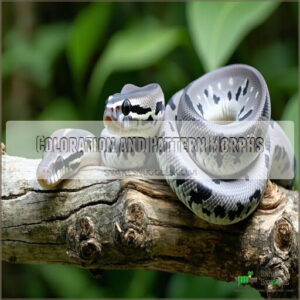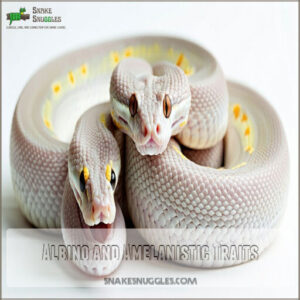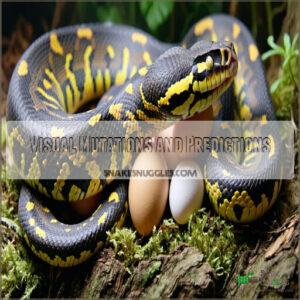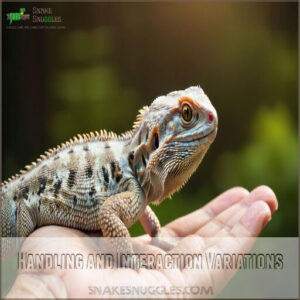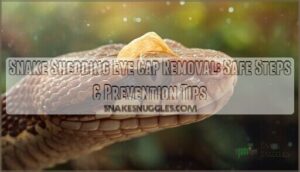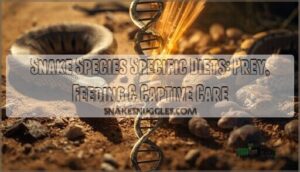This site is supported by our readers. We may earn a commission, at no cost to you, if you purchase through links.

It’s all about understanding how genes interact to create unique traits and morphs. By grasping concepts like dominant and recessive genes, genotype, and phenotype, you’ll be able to predict offspring outcomes.
Reptile genetics for beginners is a fascinating world where science meets hobby, and with the right knowledge, you’ll be breeding like a pro.
Discover the intricacies of reptile genetics and take your hobby to the next level with valuable insights into creating new and exciting morphs.
Table Of Contents
- Key Takeaways
- Reptile Genetics Basics
- Genetic Traits and Morphs
- Breeding and Selection Process
- Reptile Care and Species Selection
- Choosing The Right Reptile
- Frequently Asked Questions (FAQs)
- What is reptile breeding?
- How do I get started with reptile breeding?
- What are the different types of reptile genetics and morphs?
- Should you learn reptile breeding & reproduction?
- How long does it take to breed a reptile?
- What equipment is required for reptile breeding?
- What is the easiest reptile for beginners?
- How much can reptile breeders make?
- How many chromosomes do snakes inherit from each parent?
- Are reptiles good pets for beginners?
- Conclusion
Key Takeaways
- You’ll learn that understanding dominant and recessive genes is crucial for predicting offspring traits and creating unique morphs in reptile breeding.
- You’ll discover how to use tools like Punnett squares to map out potential offspring combinations and anticipate which traits will show up in your reptiles.
- You’ll find that reptile care and species selection are critical to a reptile’s genetic expression and overall well-being, and you’ll need to consider factors like size, habitat, and dietary needs.
- You’ll get started with reptile breeding by researching breeds, understanding genetics, and setting up a suitable environment, and you’ll learn that it takes time, patience, and planning to breed reptiles successfully.
Reptile Genetics Basics
You’re about to learn the fundamentals of reptile genetics, which will help you understand how morphs are created and inherited.
By grasping the basics of gene expression, inheritance, and DNA, you’ll be well on your way to becoming a knowledgeable reptile enthusiast.
Gene Expression and Inheritance
You’re diving into reptile genetics, where the genetic code reveals trait inheritance.
Gene mapping and DNA sequencing show heredity patterns, connecting genotype to phenotype, and guiding your understanding of gene expression in reptile genetics.
A fundamental concept in inheritance, gene expression is crucial for understanding how traits are passed down through generations in reptile genetics.
Dominant and Recessive Genes
You’ll explore dominant and recessive genes in reptile genetics.
- 1 gene type
- 2 allele options
- 3 trait outcomes
- 4 genotype combinations
- 5 phenotype expressions, understanding Gene Expression and Trait Inheritance with dominant and recessive genes.
Genotype and Phenotype
You’re learning reptile genetics basics, understanding genotype and phenotype.
Genotype refers to genetic code, while phenotype is trait expression.
Gene interaction influences phenotypic variance, following hereditary patterns, with dominant and recessive genes shaping your reptile’s appearance.
DNA and Chromosomes
DNA and chromosomes are key to reptile genetics.
DNA, the famous double helix, carries the code for all traits.
It’s like an instruction manual with chapters (chromosomes) and words (genes).
Each gene provides directions for a specific trait.
Here’s a quick overview:
- "DNA replication guarantees accurate copying of genetic information."
- "Gene coding translates DNA instructions into proteins, the workhorses of cells."
- "Cellular division distributes chromosomes evenly, to ensure each new cell gets a complete set."
- "Genetic variation arises from changes in DNA sequences, leading to unique traits."
- "Reptile DNA and chromosomes follow these same principles, shaping their characteristics.
Understanding ball python genetics is important for breeders to create unique morphs.
Genetic Traits and Morphs
You’ll discover how genetic traits shape your reptile’s unique appearance, from striking albino patterns to stunning scale variations.
Your understanding of basic inheritance patterns will help you predict which fascinating morphs you can expect when breeding your reptiles.
Coloration and Pattern Morphs
The fascinating world of color morphs opens up endless possibilities in reptile breeding.
You’ll find an incredible array of pigment genetics at work, from subtle scale patterns to striking mutations.
Ball python morphs showcase nature’s artistic side, while leopard gecko morphs display remarkable pattern inheritance.
Breeders are constantly developing new reptile morphs, expanding the possibilities within the reptile hobby.
| Morph Type | Visual Impact | Breeding Complexity |
|---|---|---|
| Piebald | High contrast patches | Moderate |
| Spider | Web-like patterns | Complex |
| Ghost | Subtle fade effects | Simple |
Now let’s explore how these stunning variations manifest in the most popular reptile species, showcasing the artistic side of nature and the remarkable pattern inheritance with each new reptile morph.
Albino and Amelanistic Traits
The field of albino genetics opens up a striking palette of possibilities in reptile breeding.
When you’re working with albino and amelanistic traits, you’ll notice these distinct characteristics:
- Complete absence of melanin results in white or pale yellow scales
- Pink or reddish eyes due to visible blood vessels
- Reduced UV protection requires careful habitat management
- Higher visibility makes them vulnerable in the wild but stunning in captivity
Understanding the effects of melanin production is essential for successful reptile breeding and care.
Co-Dominant and Incomplete Dominance
Understanding gene interactions can be as exciting as discovering a treasure chest.
When you’re working with co-dominant traits, both genes in a pair show their effects simultaneously – like mixing yellow and blue paint to get green.
In incomplete dominance, you’ll see a blend where the heterozygous form shows traits between the dominant and recessive genes.
It’s nature’s way of creating beautiful hybrid vigor in reptile morphs, showcasing gene interactions.
Visual Mutations and Predictions
Through careful breeding and genetic mapping, you can predict visual mutations in reptile morphs with remarkable accuracy.
When working with genetic patterns, experienced breeders can forecast offspring traits using established inheritance rules.
Ball python breeders utilize morph combination genetics to achieve desired outcomes.
Color genetics follow predictable patterns across generations.
Trait inheritance determines visual variations in offspring.
Mutation types create distinct morph combinations.
Reptile morphs express differently based on gene pairs.
Visual predictions help plan breeding projects effectively, allowing for more accurate forecasting of offspring traits and enabling breeders to make informed decisions about their breeding programs.
Breeding and Selection Process
You’ll discover the fascinating world of reptile genetics through essential breeding tools like Punnett squares, which predict offspring traits with remarkable accuracy.
By learning selective breeding techniques and proper record-keeping methods, you can create stunning morphs while maintaining healthy genetic lines in your reptile collection, utilizing selective breeding techniques effectively.
Punnett Squares and Predictions
Now that you’ve seen how different morphs appear, let’s explore how to predict genetic outcomes in your breeding projects.
Punnett squares are your crystal ball into trait probability. This simple grid helps you map out potential offspring combinations, showing you the odds of getting specific traits.
| Genetic Term | What It Means |
|---|---|
| BB | Pure dominant |
| Bb | Mixed (heterozygous) |
| bb | Pure recessive |
| Het | Carries hidden trait |
| Homo | Shows visible trait |
When you’re breeding reptiles, think of Punnett squares as your genetic calculator – they’ll help you anticipate which babies might show up in your clutch, using Punnett squares to understand trait probability.
Selective Breeding and Record Keeping
When diving into selective breeding, keeping thorough records is your roadmap to success.
You’ll need to track each reptile’s genetic history, breeding dates, and offspring outcomes.
Document important details like morph predictions, Punnett square calculations, and pedigree analysis results.
For ethical breeding practices, maintain detailed genetic testing records to avoid potential health issues.
Consider using specialized software to organize your breeding strategies.
Effective reptile breeding relies on utilizing reptile breeding tools to streamline the process.
Heterozygous and Homozygous Snakes
In the field of snake breeding, heterozygous and homozygous snakes represent different genetic combinations that determine their appearance.
You’ll need to understand these terms for successful breeding outcomes:
- Homozygous snakes carry identical copies of a specific gene
- Heterozygous snakes have two different versions of the same gene
- Gene expression varies between these types
- Inheritance patterns follow predictable rules
- Genetic testing can confirm their status
These genetic foundations shape your breeding journey and help predict which morphs you’ll produce. Think of it as nature’s blueprint for creating stunning snake varieties.
Possible and Proven Hets
Understanding possible hets in snake genetics requires patience and careful breeding trials.
When you’re working with heterozygous animals, you’ll need breeding results to confirm their genetic makeup.
Unlike proven hets, which have demonstrated their genetic traits through successful breeding, possible hets carry uncertain potential.
Through systematic breeding programs and detailed record keeping, you can transform possible hets into proven ones, increasing their value substantially.
Mastering snake breeding genetics involves understanding genetic variation principles to make informed decisions about breeding programs.
This process requires a deep understanding of how genetic traits are passed down, allowing breeders to make informed decisions and predict outcomes with greater accuracy, ultimately leading to successful snake breeding and a better grasp of genetic makeup.
Reptile Care and Species Selection
You’ll need to evaluate your reptile’s potential size, habitat needs, and dietary requirements before bringing one home, as these factors directly impact their genetic expression and overall well-being.
Whether you’re drawn to a bearded dragon’s easygoing nature or a ball python’s stunning morphs, you’ll find that matching your lifestyle with your reptile’s care needs leads to a rewarding partnership.
Size and Growth Considerations
Before diving into reptile genetics, let’s explore how size impacts your pet’s development.
Growth rates vary dramatically among morphs, affecting their final body proportions and size limits. When selecting your scaly companion, consider these scaling factors:
- Ball pythons typically reach 4-5 feet, with some morphs showing slower growth
- Bearded dragons grow 16-24 inches, regardless of genetic traits
- Crested geckos stay compact at 5-8 inches, perfect for smaller spaces
The provided list highlights the varying growth patterns among different reptile species, emphasizing the importance of understanding these factors for potential pet owners.
Habitat and Environmental Needs
Just as your reptile’s size shapes their needs, their habitat plays a starring role in their well-being.
You’ll need to recreate their natural environment with precision. Here’s a quick guide to the key environmental factors:
| Element | Why It Matters | Control Method |
|---|---|---|
| Temperature | Powers metabolism | Thermostats, heat lamps |
| Humidity | Aids shedding | Misting systems |
| Lighting | Supports health | UVB fixtures |
Let’s explore how to perfect your pet’s paradise by mastering these environmental elements, which are crucial for their well-being and require precise control.
Handling and Interaction Variations
Once you’ve set up the perfect habitat, it’s time to master handling your scaly friend.
Different species have unique temperament types – while ball pythons might act like living scarves, bearded dragons often become social butterflies.
You’ll want to study your pet’s interaction styles and body language carefully.
Learning these species behavior patterns helps guarantee both owner safety and a happy pet during handling sessions.
Dietary Needs and Feeding Habits
Many reptiles thrive on distinct dietary patterns that match their genetic makeup. You’ll need to align feeding schedules with your pet’s natural rhythms for effective digestive health.
Proper reptile nutrition care tips are essential for their well-being. Here’s what your scaly friend needs:
- Live prey feeders require careful timing and prey size selection
- Herbivores need fresh greens and specific nutrient-rich vegetables daily
- Omnivores benefit from varied diets combining proteins and plant matter
- Supplement needs vary by species and life stage
- Food sources should match your pet’s natural preferences to ensure effective digestive health and a long, healthy life with your scaly friend and provide the best reptile nutrition care.
Choosing The Right Reptile
You’ll find selecting your first reptile easier once you understand how their genetics influence traits like size, temperament, and care requirements.
Whether you’re drawn to a bearded dragon’s friendly personality or a ball python’s striking morphs, you’ll need to match your choice with your experience level and available resources.
Beginner-Friendly Species and Morphs
You’re looking for pet choices with exciting morph variations.
Leopard geckos and ball pythons are great options, offering various color patterns.
They’re perfect for beginners learning reptile genetics, with a range of morphs to explore, making them ideal species for those new to breeding basics and reptile genetics for beginners.
Cost and Availability Considerations
When buying a pet reptile, consider breeding costs, pet prices, and market trends.
Species availability and purchase fees vary, affecting the reptile cost.
As a beginner in reptile genetics, research these factors to make an informed decision, ensuring you find the right pet reptiles within your budget.
Understanding the total reptile pet cost is essential for making a well-informed purchase decision.
Health and Behavior Factors
As you consider a reptile, remember health and behavior factors, including:
- Morph Health
- Behavioral Traits
- Genetic Disorders
- Environmental Impact
to guarantee your pet’s well-being and prevent health issues, such as developmental abnormalities, through proper nutrition and care.
Research and Preparation Requirements
You’re almost ready to bring home your new reptile.
Research breeding plans, genetic testing, and data analysis to guarantee a healthy pet.
| Research Methods | Data Analysis |
|---|---|
| Literature Review | Statistical Models |
| Breeding Plans | Genetic Testing |
| Reptile Genetics Guide | Understanding Reptile Genetics |
| Beginner Reptile Genetics | Reptile Genetics 101 |
| Reptile Care | Handling Techniques |
The table outlines various research methods and data analysis techniques, including literature review, statistical models, and genetic testing, which are essential for understanding reptile genetics.
Frequently Asked Questions (FAQs)
What is reptile breeding?
You’re about to uncover the fascinating world of reptile breeding, where genetic traits and careful planning come together to create unique, enchanting creatures.
How do I get started with reptile breeding?
You’ll start by researching breeds, understanding genetics, and setting up a suitable environment to secure a successful and healthy reptile breeding experience, requiring patience and dedication.
What are the different types of reptile genetics and morphs?
You’ll explore dominant, recessive, and co-dominant genes, plus various morphs like albino, anerythristic, and axanthic, which affect reptile appearance.
Should you learn reptile breeding & reproduction?
You should learn reptile breeding and reproduction to understand genetics, predict offspring traits, and make informed decisions as a responsible reptile owner and potential breeder.
How long does it take to breed a reptile?
You’ll find that breeding reptiles takes time, patience, and planning, often several months to years, depending on species, genetics, and desired outcomes, requiring careful consideration and execution.
What equipment is required for reptile breeding?
You’ll need enclosures, heat sources, lighting, thermometers, and humidity gauges to breed reptiles, ensuring a suitable environment for your scaled friends to thrive.
What is the easiest reptile for beginners?
You’ll discover bearded dragons are often considered the easiest reptile for beginners, given their easygoing temperament, relatively low maintenance, and affordable cost, making them a great starting point.
How much can reptile breeders make?
You can earn a significant income as a reptile breeder, with prices ranging from $40 to $1,000 or more per animal, depending on species, morph, and breeder reputation.
How many chromosomes do snakes inherit from each parent?
You inherit a whopping half of your snake’s chromosomes from each parent, totaling a pair, with each parent contributing one chromosome to form a complete set.
Are reptiles good pets for beginners?
You’ll find reptiles can make great pets for beginners, offering a unique experience with proper care and research, they’re relatively low-maintenance and quite fascinating.
Conclusion
You’re now on the right track, having cut your teeth on reptile genetics for beginners.
Mastering this field takes time, but with practice, you’ll be breeding unique morphs in no time.
Reptile genetics for beginners is key to discovering exciting new traits, so keep learning and experimenting to become a pro in this fascinating world of reptile genetics for beginners.
- https://newenglandreptilestore.com/pages/intro-to-reptile-genetics
- https://arbreptiles.com/genetics101.html
- https://theurbanreptile.com/2021/01/27/reptile-genetics/
- https://animaldiversity.org/accounts/Uromastyx_acanthinura/
- https://www.acs.org/content/acs/en/pressroom/presspacs/2013/acs-presspac-february-6-2013/frog-in-bucket-of-milk-folklore-leads-to-potential-new-antibiotics.html


